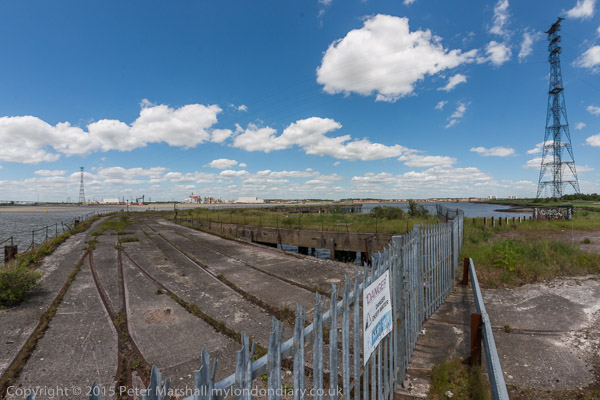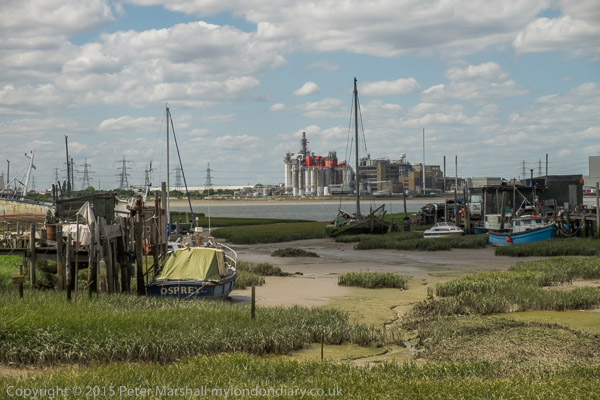
Coal Wharf at Bell Wharf, Swanscombe. A ropeway took coal to the factory
I’m still working on my North Kent book with images from the 1980s that I’ve mentioned here before, and looking at some of the images from back then made me want to go there again, especially since parts of the area are changing.
Of course I have returned occasionally over the years, and published and exhibited some later images, such as those in Estuary and my book Thamesgate Panoramas (as always those with UK addresses can order the print version more cheaply direct from me, though I recommend the PDF from Blurb at £4.99.)

Where the Eurostar emerges from under the River Thames
One particular area under threat is the Swanscombe Peninsula, a triangular area of Kent that juts out towards Essex a little to the west of Gravesend. It’s both an ancient and a modern crossing point, where pilgrims crossed the river on their way to Canterbury, and where enormous pylons, 623 ft high, carry the National Grid across, while the HS1 Eurostars dive into a a tunnel at high speeds close to Ebbsfleet station (where just a few stop) though the more local Javelin services reduce the journey times to central London to 18 minutes for the wealthy. There are plans for what sounds like a particularly tacky theme park based on films and TV programmes which has government backing to cover the whole area.

Pilgrims Road – and a giant pylon in the distance on the opposite side of the Thames
I took the slow route to Swanscombe station on a Gravesend train. The time difference for me is minimal, as the fast trains go into St Pancras, to the north of London, and I can catch the slower trains far more conveniently at Waterloo East, and get there about as quickly but with much less climbing up and down and walking in stations. This was important as I was taking my Brompton with me and together with my cameras it adds up to quite a weight. Best not to carry it at all – and I didn’t need to on the marginally slower route.
This kind of consideration makes me wonder about the calculations presented to justify prestige transport projects, such as HS2 against the less sexy options of increasing traffic on existing routes. Shaving a few minutes off the time from Birmingham to London isn’t a big deal if you end up in Old Oak Common – or at the other end you come into Curzon St when your onward journey is from New Street station. Changing the London terminus for Eurostar from Waterloo to St Pancras might have cut the Eurostar journey times, but had no effect on my overall journey times for that matter.
When I first visited Swanscombe it was in parts a desolate wilderness, with heaps of waste from the former cement works, which was still standing. Disused rails led to fenced off piers. Everything now is rather more overgrown, but otherwise much of the peninsula has a similar feel.

Bell Wharf: coal and clay came in, and cement was sent out. Taken standing on the Brompton
I didn’t find Broadness salt marshes in my early explorations of the area, taking a more inland route and missing it. One of my favourite landscape pictures was taken there in 2006, but I’d never fully explored the area, and this was just one of the things I set out to do.

And I took a similar view to the one, that I’d made 9 or so years ago, though then the tide was rather higher, with the creek filled with water.
The creek is at a dead end – probably why I’d not bothered to go to it in the early days. Then I always went on foot, slow, sometimes exhausting, but still the beast way to see the country. Taking a bike enables me to cover more ground and in areas like this can be ridden along footpaths as well as roads, It means I’m happy to go half a mile down a dead end knowing I’ll just have to ride back, whereas on foot I might well decide not to bother. From here I came back and cycled to another dead end, opposite the Tilbury Docks, before returning and going back by Botany marshes, now rather more domesticated as a nature reserve.
The bike is also useful for photographing over walls and fences. Several images in the Swanscombe set were made with the Brompton leaning against a wall or fence and with me standing one foot on the saddle and the other on the handlebars. There is a tendency for it to roll away dangerously but it does add a useful couple of feet to my stature.
Rather than a normal camera bag, I was using a Brompton bag which fits on the front of the bicycle, and working with two cameras, the Nikon D800E with the 16mm full-frame fisheye, and the Fuji X-T1 with Fuji X 10-24mm (15-36mm equiv) and 18-55mm (27-82mm equiv.) The Nikon images have been converted into a cylindrical perspective with horizontal angle of view around 146 degrees.
For most of the day both cameras worked perfectly, but on the way back to the station I stopped briefly to take some pictures looking south from the main road, which runs along the narrow spine of chalk left between two large quarries. I wanted to be sure to get good detail so I turned the ISO dial on the Fuji X-T1 down to 200. Unfortunately the dial below the ISO dial, the Drive dial, turned as well, into the so-called ‘Advanced Filter’ position, with disastrous results.

Fuji’s ‘Advanced’ filter uncorrected. I’m not sure whether this was ‘Toy Camera’, ‘Minature’ or ‘Pop Colour’
The Advanced Filter selection is a clear case where more is less, a capability the camera would be better without, though presumably marketing don’t think so. There are perhaps people who want a setting that destroys your images in camera rather than leaving that to Photoshop, but I’m not one of them.

A near identical frame after considerable general and local work in Lightroom
Worse still, not only do the ‘Advanced filters’ mess up your pictures with silly effects, they also switch from Raw to jpeg. I was left with garish images, all subtlety of colour lost, and because they are jpegs it is impossible to get back to the original image. I’ve done my best with the image above, but the sky in particular remains impossible, with all cloud detail absent and some vignetting still visible. You can see the difference if you compare it with an image taken at more or less the same place using RAW with the Nikon.

Nikon D800E, 16mm fisheye. From RAW file
The default settings on the X-T1 actually make it very easy to select the filter in error, simply by pressing the Fn1 button to the right of the lens mount. It’s one of several defaults it makes sense to change to something innocuous.
On My London Diary you can see more of my pictures of Swanscombe and the adjoining areas and also read more about the area, my ride around it and the pictures.
______________________________________________________
My London Diary : Buildings of London : River Lea/Lee Valley : London’s Industrial Heritage
All photographs on this and my other sites, unless otherwise stated, are taken by and copyright of Peter Marshall, and are available for reproduction or can be bought as prints.
To order prints or reproduce images
________________________________________________________